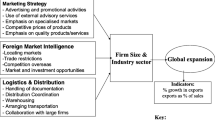Abstract
Based on a non-competitive input-output model capturing China’s processing exports, this paper establishes a goal programming model to optimize China’s export structure. In this model, China’s domestic production is divided into three parts: Production for domestic use, processing exports, and non-processing exports and production for other foreign invested enterprises. This division enables differentiation of the effects of various trade patterns, on the basis of which the authors conduct an empirical analysis using 2002 data, to obtain a Pareto optimality.
Similar content being viewed by others
References
Wu Y P, Shen X Y, and Hu T, The new trend toward green trade policy following the worldwide financial crisis: Using the restrictions of “high-pollution, high energy-consuming and resourcedependent” products as examples, Environmental Economy, 2008, 11: 32–34 (in Chinese).
Cui W, Wang L Y, and Wang H W, Prediction and analysis of composition of export commodity in China, Systems Engineering, 2003, 21(4): 56–60 (in Chinese).
Zhang H X, A long-term macroeconomic predicting model, method and application, Dalian University of Technology, 2001 (in Chinese).
Zhang W and Pan W Q, An input-output optimization model to reflect the effects of tariff adjustment, The Journal of Quantitative & Technical Economics, 2003, 7: 93–95 (in Chinese).
Jiang T, Yuan J H, He L, and Xu Y, An analyzing model system on population, resources, environment and economics, Systems Engineering — Theory & Practice, 2002, 12: 67–72 (in Chinese).
Lau L J, Chen X K, Yang C H, Cheng L K, Fung K C, Sung Y W, Zhu K F, Pei J S, and Tang Z P, Input-occupancy-output models of the non-competitive type and their application — An examination of the China-US trade Surplus, Social Sciences in China, 2010, 31(1): 35–54.
Lau L J, Chen X K, Yang C H, et al., Input-occupancy-output models of the non-competitive type and their application — An examination of the China-US trade surplus, Social Sciences in China, 2010, 31(1): 35–54.
Ignizio J P, An introduction to goal programming with applications in urban systems, Computers, Environment and Urban Systems, 1980, 5(1–2): 15–33.
Tamiz M, Jones D, and Romero C, Goal programming for decision making: An overview of the current state-of-art, European Journal of Operational Research, 1998, 111: 569–581.
Wang H J and Chen X K, The extended energy-input-occupancy-output model of the noncompetitive imports type, Journal of Systems Science and Mathematical Sciences, 2009, 29(11): 1447–1456 (in Chinese).
Xiang J and Liu X L, Impact on national economy of water production and supply sectors during 1987–2005, Journal of Economics of Water Resources, 2009, 27(1): 14–18 (in Chinese).
Dietzenbacher E, Pei J S, and Yang C H, Trade, production fragmentation, and China’s carbon dioxide emissions, Journal of Environmental Economics and Management, 2012, 64: 88–101.
Amador F and Romero C, Redundancy in lexicographic goal programming: An empirical approach, European Journal of Operational Research, 1989, 41: 347–354.
Charnes A and Cooper W W, Goal programming and multiple objective optimizations, European Journal of Operational Research, 1977, 1: 39–54.
Ignizio J P, A review of goal programming: A tool for multi-objective analysis, Journal of the Operational Research Society, 1978, 29(11): 1109–1119.
Author information
Authors and Affiliations
Corresponding author
Additional information
This research was supported by the National Natural Science Foundation of China under Grant Nos. 71125005, 70871108, and 70810107020; Outstanding Talents Funds of Organization Department, Beijing Committee of CPC.
This paper was recommended for publication by Editor TANG Xijin.
Rights and permissions
About this article
Cite this article
Mu, Z., Yang, C. Optimizing China’s export structure combining goal programming and non-competitive input-output model. J Syst Sci Complex 27, 712–728 (2014). https://doi.org/10.1007/s11424-014-1112-6
Received:
Revised:
Published:
Issue Date:
DOI: https://doi.org/10.1007/s11424-014-1112-6




